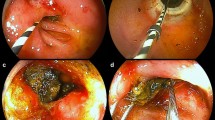Abstract
Background
Recently, single definitive hepaticojejunostomy has been proposed to replace two-stage procedures, including initial urgent biliary drainage and final biliary reconstruction, with a reduced hospitalization time and corresponding overall hospitalization cost. We aimed to investigate the safety and efficacy of the initial definitive operation compared with the two-stage approach.
Methods
The medical records of patients with perforated CDCs managed between 2010 and 2017 were retrospectively reviewed. The qualified samples were divided according to a single definitive operation or two-stage approach. We conducted a comparison of the clinical characteristics, including surgical parameters, length of stay, and short- and intermediate-term complications.
Results
A total of 117 patients with perforated CDCs were reviewed, with 48 cases of single-stage management and 69 cases of two-stage management. No differences in the baseline characteristics between the two groups were found, such as age, sex distribution, ultrasound presentation, or laboratory findings. The initial definitive operation was associated with a lower total duration of drainage, including abdominal drainage and biliary drainage (p < 0.001), and rate of unplanned readmission (OR, 0.056; 95% CI 0.007–0.435; p < 0.001) than those who underwent two-stage management. Furthermore, the initial definitive operation significantly reduced the postoperative hospital stay (p < 0.001), and the overall hospitalization cost was accordingly reduced compared with two-stage management (p < 0.001).
Conclusions
The initial single definitive operation was safe and effective for most of the patients with perforated CDCs when expertise was available. Therefore, a single definitive operation should be considered the treatment of choice for perforated CDCs.
Similar content being viewed by others
References
de Vries JS, de Vries S, Aronson DC, Bosman DK, Rauws EA, Bosma A, et al. Choledochal cysts: age of presentation, symptoms, and late complications related to Todani’s classification. J Pediatr Surg. 2002;37:1568–73.
Kim SH, Cho YH, Kim HY. Perforated choledochal cyst: its clinical implications in pediatric patient. Pediatr Gastroenterol Hepatol Nutr. 2020;23(3):259–65. https://doi.org/10.5223/pghn.2020.23.3.259.
Soares KC, Goldstein SD, Ghaseb MA, Kamel I, Hackam DJ, Pawlik TM. Pediatric choledochal cysts: diagnosis and current management. Pediatr Surg Int. 2017;33(6):637–50. https://doi.org/10.1007/s00383-017-4083-6.
Arda IS, Tuzun M, Aliefendioglu D, Hicsonmez A. Spontaneous rupture of extrahepatic choledochal cyst: two pediatric cases and literature review. Eur J Pediatr Surg. 2005;15:361–3.
Lal R, Agarwal S, Shivhare R, Kumar A, Sikora SS, Kapoor VK, et al. Management of complicated choledochal cysts. Dig Surg. 2007;24:456–62. https://doi.org/10.1159/000111821.
Saluja SS, Nayeem M, Sharma BC, Bora G, Mishra PK. Management of choledochal cysts and their complications. Am Surg. 2012;78(3):284–90.
Ohba G, Yamamoto H, Nakayama M, Honda S, Taketomi A. Single-stage operation for perforated choledochal cyst. J Pediatr Surg. 2018;53(4):653–5.
Diao M, Li L, Cheng W. Single-incision laparoscopic hepaticojejunostomy for children with perforated choledochal cysts. Surg Endosc. 2018;32(7):3402–9.
Dellinger RP, Levy MM, Carlet JM, Bion J, Parker MM, Jaeschke R, et al. Surviving Sepsis Campaign: international guidelines for management of severe sepsis and septic shock: 2008. Crit Care Med. 2008;36(1):296–327.
Huang CS, Huang CC, Chen DF. Choledochal cysts: differences between pediatric and adult patients. J Gastrointest Surg. 2010;14:1105–10.
Meschino M, García-Ochoa C, Hernandez-Alejandro R. Ruptured choledochal cyst: a rare presentation and unique approach to management. Hepatobiliary Surg Nutr. 2015;4(1):E8–12. https://doi.org/10.3978/j.issn.2304-3881.2014.08.09.
Franga DL, Howell CG, Mellinger JD, Hatley RM. Single-stage reconstruction of perforated choledochal cyst: case report and review of the literature. Am Surg. 2005;71(5):398–401.
Kang CM, Lee KH, Kim DH, Lee WJ. Percutaneous transhepatic cyst drainage as a “bridge procedure” to definitive treatment of perforated choledochal cysts: a case report. Surg Laparosc Endosc Percutan Tech. 2008a;18(6):598–600.
Minagawa T, Dowaki S, Kikunaga H, et al. Endoscopic biliary drainage as a bridging procedure to single-stage surgery for perforated choledochal cyst: a case report and review of the literature. Surg Case Rep. 2015;1(1):117. https://doi.org/10.1186/s40792-015-0115-4.
Kang CM, Lee KH, Kim DH, Lee WJ. Percutaneous transhepatic cyst drainage as a “bridge procedure” to definitive treatment of perforated choledochal cysts: a case report. Surg Laparosc Endosc Percutan Tech. 2008b;18:598–600. https://doi.org/10.1097/SLE.0b013e31818096a0.
Wang X, Yu WL, Fu XH, Zhu B, Zhao T, Zhang YJ. Early versus delayed surgical repair and referral for patients with bile duct injury: a systematic review and meta-analysis. Ann Surg. 2020;271:449–59.
Wu CH, Ho TW, Wu JM, Kuo TC, Yang CY, Lai FP, Tien YW. Preoperative biliary drainage associated with biliary stricture after pancreaticoduodenectomy: a population-based study. J Hepatobiliary Pancreat Sci. 2018;25(6):308–18.
Ma MX, Jayasekeran V, Chong AK. Benign biliary strictures: prevalence, impact, and management strategies. Clin Exp Gastroenterol. 2019;18(12):83–92.
Sharaiha RZ, Khan MA, Kamal F, Tyberg A, Tombazzi CR, Ali B, Tombazzi C, Kahaleh M. Efficacy and safety of EUS-guided biliary drainage in comparison with percutaneous biliary drainage when ERCP fails: a systematic review and meta-analysis. Gastrointest Endosc. 2017;85(5):904–14.
Meschino M, García-Ochoa C, Hernandes-Alejandro R. Ruptured choledochal cyst: a rare presentation and unique approach to management. Hepatobiliary Surg Nutr. 2015;4:E8–12.
Ohashi T, Wakai T, Kubota M, Matsuda Y, Arai Y, Ohyama T, et al. Risk of subsequent biliary malignancy in patients undergoing cyst excision for congenital choledochal cysts. J Gastroenterol Hepatol. 2013;28:243–7. https://doi.org/10.1111/j.1440-1746.2012.07260.x.
Acknowledgements
We thank Prof. Lei Li for providing technical assistance and for insightful discussions during the preparation of the manuscript. We thank Dr Xiaoyong Zhang at the Wistar Institute, USA, for help with the linguistic revision of the manuscript.
Author information
Authors and Affiliations
Contributions
XW, FY and CG designed the study, analyzed the data and evaluated the manuscript. KG performed the statistical measurements and analyzed the data. CG and CY wrote the paper.
Corresponding author
Ethics declarations
Conflicts of interest
No potential conflicts of interest relevant to this article are reported.
Ethical approval
The research was supported by the National Natural Science Foundation of China (Nos: 30973440, 30770950) and the key project of the Chongqing Natural Science Foundation (CSTC, 2008BA0021, cstc2012jjA0155).
Rights and permissions
About this article
Cite this article
Wang, X., Gao, K., Yan, C. et al. Short- and intermediate-term evaluation of the initial definitive operation for perforated choledochal cysts compared to two-stage management. Eur J Trauma Emerg Surg 48, 1129–1135 (2022). https://doi.org/10.1007/s00068-020-01553-4
Received:
Accepted:
Published:
Issue Date:
DOI: https://doi.org/10.1007/s00068-020-01553-4




